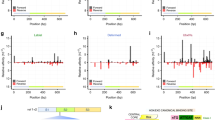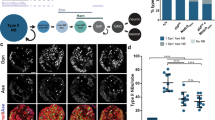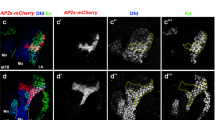Abstract
THE segmentation of the Drosophila body plan depends on a hierarchy of interactions among ˜20–25 regulatory genes that are active in the early embryo (refs 1–4; for a review see ref. 5). The gap genes have a key role in this process and are responsible for the periodic expression of certain pair-rule genes6–8 and the localized expression of several homoeotic genes9–11. The two best characterized gap genes, hunchback (hb) and Krüppel (Kr) contain homologies with the zinc-finger DNA-binding motif12,13, although their mode of action in the early embryo is unknown. Here we report that both of the proteins encoded by these genes possess sequence-specific DNA-binding activities, which indicates that they might regulate gene expression at the level of transcription. The binding sites of the hb gene product are related by a 10-base pair (bp) consensus sequence, G/AC/CTAAAAAA, whereas the binding sites of the Kr gene product share a distinct 10-bp motif, AACGGGTTAA. It is possible that the hb and Kr proteins cooperatively regulate gene expression, because they are expressed in broad, overlapping gradients in the early embryo. We also provide evidence that the on/off periodicity of the pair-rule gene even-skipped (eve) 14,15 involves the interaction of the hb and Kr proteins with defined eve promoter elements16,17.
This is a preview of subscription content, access via your institution
Access options
Subscribe to this journal
Receive 51 print issues and online access
$199.00 per year
only $3.90 per issue
Buy this article
- Purchase on Springer Link
- Instant access to full article PDF
Prices may be subject to local taxes which are calculated during checkout
Similar content being viewed by others
References
Nüsslein-Volhard, C. & Wieschaus, E. Nature 287, 795–801 (1980).
Nüsslein-Volhard, C., Wieschaus, E., & Kluding, H. Wilhelm Roux Arch. dev. Biol. 193, 267–282 (1984).
Jurgens, G., Wieschaus, E., Nüsslein-Volhard, C. & Kluding, H. Wilhelm Roux Arch. dev. Biol. 193, 283–295 (1984).
Wieschaus, E., Nüsslein-Volhard, C. & Jurgens, G. Wilhelm Roux Arch. dev. Biol. 193, 296–307 (1984).
Ingham, P. W. Nature 335, 25–34 (1988).
Carroll, S. B. & Scott, M. P. Cell 45, 113–126 (1986).
Ingham, P. W., Ish-Horowicz, D. & Howard, K. R. EMBO J. 5, 1659–1665 (1986).
Frasch, M. & Levine, M. Genes Dev. 1, 981–995 (1987).
White, R. A. H. & Lehmann, R. Cell 47, 311–321 (1986).
Harding, K. & Levine, M. EMBO J. 7, 205–214 (1988).
Irish, V. F., Martinez-Arias, A. & Akam, M. EMBO J. 8, 1527–1538 (1989).
Rosenberg, U. B. et al. Nature 319, 336–340 (1986).
Tautz, D. et al. Nature 327, 383–387 (1987).
Macdonald, P. M., Ingham, P. W. & Strühl, G. Cell 47, 721–730 (1986).
Frasch, M., Hoey, T., Rushlow, C., Doyle, H. & Levine, M. EMBO J. 6, 749–759 (1987).
Harding, K., Hoey, T., Warrior, R. & Levine, M. EMBO J. 8, 1205–1212 (1989).
Goto, T., Macdonald, P. & Maniatis, T. Cell 57, 413–422 (1989).
Harding, K., Ruhslow, C., Doyle, H. J., Hoey, T. & Levine, M. Science 233, 953–957 (1986).
Gaul, U. and Jäckle, H. Trends Genet. 3, 127–133 (1987).
Gaul, U., Seifert, E., Schuh, R. & Jäckle, H. Cell 50, 639–647 (1987).
Tautz, D. Nature 332, 281–284 (1988).
Miller, J., McLachlan, A. D. & Klug, A. EMBO J. 4, 1609–1614 (1985).
Redemann, N., Gaul, U. & Jäckle, H. Nature 332, 90–92 (1988).
Ollo, R. & Maniatis, T. Proc. natn. Acad. Sci. U.S.A. 84, 5700–5704 (1987).
Keleher, C., Goutte, C. & Johnson, A. D. Cell 53, 927–936 (1988).
Han, K., Levine, M. & Manley, J. L. Cell 56, 573–583 (1989).
Studier, F. W. & Moffatt, B. A. J. molec. Biol. 189, 113–130 (1986).
Hoey, T. & Levine, M. Nature 332, 858–861 (1988).
Heberlein, U., England, B. & Tjian, R. Cell 41, 965–977 (1985).
Schröeder, C., Tautz, D., Seifert, F. & Jäckle, H. EMBO J. 7, 2881–2887 (1989).
Author information
Authors and Affiliations
Rights and permissions
About this article
Cite this article
Štanojević, D., Hoey, T. & Levine, M. Sequence-specific DNA-binding activities of the gap proteins encoded by hunchback and Krüppel in Drosophila. Nature 341, 331–335 (1989). https://doi.org/10.1038/341331a0
Received:
Accepted:
Issue Date:
DOI: https://doi.org/10.1038/341331a0
This article is cited by
-
Molecular cloning, expression, and stress response of the estrogen-related receptor gene (AccERR) from Apis cerana cerana
The Science of Nature (2016)
-
A typical RNA-binding protein gene (AccRBM11) in Apis cerana cerana: characterization of AccRBM11 and its possible involvement in development and stress responses
Cell Stress and Chaperones (2016)
-
cis-regulatory analysis of the Drosophila pdm locus reveals a diversity of neural enhancers
BMC Genomics (2015)
-
Promoter analysis and RNA interference of CYP6ab4 in the silkworm Bombyx mori
Molecular Genetics and Genomics (2015)
-
Molecular identification and stress response of the apoptosis-inducing factor gene 3 (AccAIF3) from Apis cerana cerana
Apidologie (2014)
Comments
By submitting a comment you agree to abide by our Terms and Community Guidelines. If you find something abusive or that does not comply with our terms or guidelines please flag it as inappropriate.



